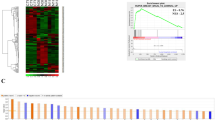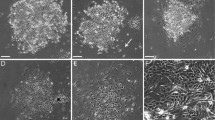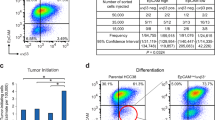Summary
We report the establishment of a breast epithelial cell model that undergoes growth arrest at different stages of the cell cycle depending upon the DNA damaging agents encountered. Primary breast epithelial cells from normal reductive mammoplasty were grown in low-calcium culture medium. Free-floating cells under this condition were separated and used for establishment of the MCF-15 breast epithelial cell line. We found that MCF-15 breast epithelial cells display a superb response to different phases of the cell cycle arrest in response to various DNA damaging agents. Immunohistological analysis indicates that MCF-15 cells express cytokeratin 19, CD44, CXCR4, SDF-1, SPARC and vimentin. Although less than 5% of the MCF-15 cells expressed Muc-1 in culture, increased Muc-1 expression was observed in luminal epithelial cells along the newly formed lumen in xenografts. Furthermore, a small population of MCF-15 cells expressed estrogen receptor-α (ERα) in xenografts while ERα expression was not detected in monolayer culture. Therefore, the MCF-15 breast epithelial cell line possesses characteristics of breast progenitor cells and provides a good cell culture model for studying the response to DNA damage and the etiology of aggressive basal-like breast cancers.
Similar content being viewed by others
References
Ethier SP Human breast cancer cell lines as models of growth regulation and disease progression J Mammary Gland Biol Neoplasia 1: 111–121, (1996)
Shackney SE, Silverman JF Molecular evolutionary patterns in breast cancer Adv Anat Pathol 10: 278–290, (2003)
Soule HD, McGrath CM A simplified method for passage and long-term growth of human mammary epithelial cells In Vitro Cell Dev Biol 22: 6–12, (1986)
Soule HD, Maloney TM, Wolman SR, Peterson WD Jr., Brenz R, McGrath CM, Russo J, Pauley RJ, Jones RF, Brooks SC Isolation and characterization of a spontaneously immortalized human breast epithelial cell line, MCF-10 Cancer Res 50: 6075–6086, (1990)
Masamura S, Santner SJ, Heitjan DF, Santen RJ Estrogen deprivation causes estradiol hypersensitivity in human breast cancer cells J Clin Endocrinol Metab 80: 2918–2925, (1995)
Wang YA, Kamarova Y, Shen KC, Jiang Z, Hahn M-J., Wang Y, Brooks SC DNA methyltransferase-3a interacts with p53 and represses p53-mediated gene expression Cancer Biol Ther 4: 1138–1143, (2005)
Wang YA, Shen KC, Wang Y, Brooks SC Retinoic acid signaling is required for proper morphogenesis of mammary gland Dev Dyn 234:892–899, (2005)
Akahani S, Nangia-Makker P, Inohara H, Kim HR, Raz A Galectin-3: a novel antiapoptotic molecule with a functional BH1 (NWGR) domain of Bcl-2 family Cancer Res 57: 5272–5276, (1997)
Bakkenist CJ, Kastan MB DNA damage activates ATM through intermolecular autophosphorylation and dimer dissociation. [see comment] Nature 421: 499–506, (2003)
Dontu G, Abdallah WM, Foley JM, Jackson KW, Clarke MF, Kawamura MJ, Wicha MS In vitro propagation and transcriptional profiling of human mammary stem/progenitor cells Genes Dev 7: 1253–1270, (2003)
Gudjonsson T, Villadsen R, Nielsen HL, Ronnov-Jessen L, Bissell MJ, Petersen OW Isolation, immortalization, and characterization of a human breast epithelial cell line with stem cell properties Genes Dev 16: 693–706, (2002)
Al-Hajj M, Wicha MS, Benito-Hernandez A, Morrison SJ, Clarke MF Prospective identification of tumorigenic breast cancer cells Proc Natl Acad Sci USA 100: 3983–3988, (2003)
Evans MJ, Kaufman MH Establishment in culture of pluripotential cells from mouse embryos Nature 292: 154–156, (1981)
Martin GR Isolation of a pluripotent cell line from early mouse embryos cultured in medium conditioned by teratocarcinoma stem cells Proc Natl Acad Sci USA 78: 7634–7638, (1981)
Perou CM, Sorlie T, Eisen MB, van de Rijn M, Jeffrey SS, Rees CA, Pollack JR, Ross DT, Johnsen H, Akslen LA, Fluge O, Pergamenschikov A, Williams C, Zhu SX, Lonning PE, Borresen-Dale AL, Brown PO, Botstein D Molecular portraits of human breast tumours Nature 406: 747–752, (2000)
Sorlie T, Perou CM, Tibshirani R, Aas T, Geisler S, Johnsen H, Hastie T, Eisen MB, van de Rijn M, Jeffrey SS, Thorsen T, Quist H, Matese JC, Brown PO, Botstein D, Eystein Lonning P, Borresen-Dale AL Gene expression patterns of breast carcinomas distinguish tumor subclasses with clinical implications Proc Natl Acad Sci USA 98: 10869–10874, (2001)
Sorlie T, Tibshirani R, Parker J, Hastie T, Marron JS, Nobel A, Deng S, Johnsen H, Pesich R, Geisler S, Demeter J, Perou CM, Lonning PE, Brown PO, Borresen-Dale AL, Botstein D Repeated observation of breast tumor subtypes in independent gene expression data sets Proc Natl Acad Sci USA 100: 8418–8423, (2003)
van't Veer LJ, Dai H, van de Vijver MJ, He YD, Hart AA, Mao M, Peterse HL, van der Kooy K, Marton MJ, Witteveen AT, Schreiber GJ, Kerkhoven RM, Roberts C, Linsley PS, Bernards R, Friend SH Gene expression profiling predicts clinical outcome of breast cancer Nature 415: 530–536, (2002)
Acknowledgements
This research was supported in part by Grants DAMD17-02-1-0619 and P30 ES06639 to YAW.
Author information
Authors and Affiliations
Corresponding author
Rights and permissions
About this article
Cite this article
Shen, K.C., Miller, F., Tait, L. et al. Isolation and characterization of a breast progenitor epithelial cell line with robust DNA damage responses. Breast Cancer Res Treat 98, 357–364 (2006). https://doi.org/10.1007/s10549-006-9173-4
Received:
Accepted:
Published:
Issue Date:
DOI: https://doi.org/10.1007/s10549-006-9173-4




